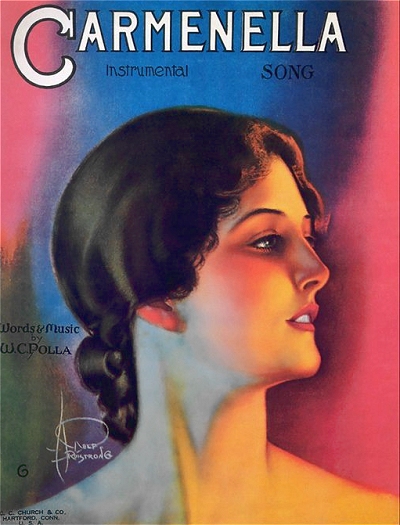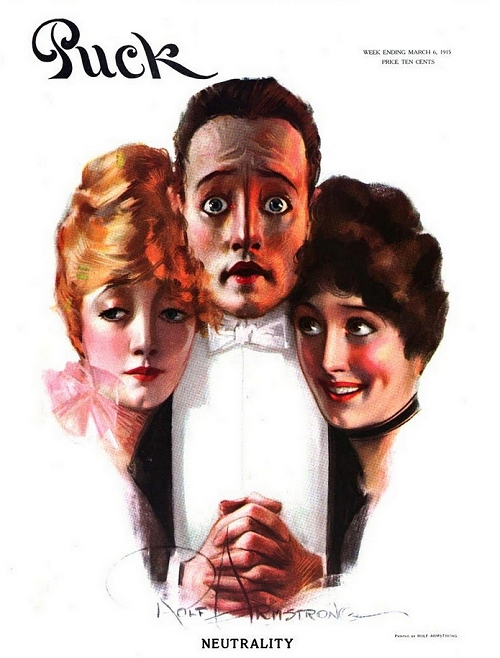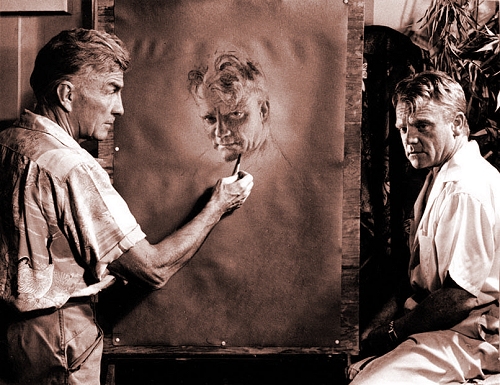

 John Scott "Rolf" Armstrong (April 21, 1889 to February 22, 1960) | |
 Selected Covers (Hover to View) Selected Covers (Hover to View) | |
Although Rolf Armstrong is well-known to sheet music collectors of 1920s material, his legacy actually goes far beyond that distribution medium, as does his fame, all in the name of art. John Scott Armstrong was the last of four children (by two decades) born to Canadian immigrant Richard Armstrong and his wife Harriet Scott, the other three being William Noah (1866), Cholula (or Chula) (8/6/1867) and Paul (4/25/1869). Richard was nearly 50 when his youngest son was born in Bay City, Michigan, and was already nearing the end of his career as a fire boat builder and tugboat/excursion captain on Saginaw Bay and Lake Huron. He also ran a farm at his residence, although the future of that and his boat business was already in question as John reached toddler status. The Bay City Daily Tribune of February 22, 1890, quoted the elder Armstrong as saying:
There is no longer a decent livelihood to be made in river trade... I will neither run a saloon, pander to low elements, or run my boats on Sunday and because of this I see no profit to river service. You may say, then, that my whole outfit, steamboats and all, is for sale. I cannot see a livelihood in this business and want to sell out. If anyone else can he may get my boats cheap... I will sell out, if I can, failing I shall do the next best thing. Place my boats as advantageously as possible and keep some of them on the river so long as they will pay expenses.
However, despite the gloomy prognostication, Armstrong managed to survive the next two years. Then in late 1892 he got a lucrative contract with the World's Columbian Exposition held in Chicago, Illinois,

 providing passenger shuttle service on Lake Michigan for the duration of the spring and summer of 1893. This was a temporary respite at best, and the gains from this had diminished with a couple of years. His son and John's brother Paul had also been a Great Lakes boat captain, but both of them seemed happy enough by the end of the 19th century to hang up their pilot's hats and pursue other avenues. Richard had also lost his farm and his family home during his economic crisis. So by 1899 the family had moved east to Detroit, Michigan. The 1900 enumeration taken in Detroit showed still claiming to be a boat owner and builder, although in what capacity by this time was unclear. Richard Armstrong died in 1903, leaving his wife and youngest son alone in the world.
providing passenger shuttle service on Lake Michigan for the duration of the spring and summer of 1893. This was a temporary respite at best, and the gains from this had diminished with a couple of years. His son and John's brother Paul had also been a Great Lakes boat captain, but both of them seemed happy enough by the end of the 19th century to hang up their pilot's hats and pursue other avenues. Richard had also lost his farm and his family home during his economic crisis. So by 1899 the family had moved east to Detroit, Michigan. The 1900 enumeration taken in Detroit showed still claiming to be a boat owner and builder, although in what capacity by this time was unclear. Richard Armstrong died in 1903, leaving his wife and youngest son alone in the world.


Harriet and John relocated west to Seattle, Washington, where William had gone to manage interests in various mines in Alaska and Canada, and would eventually participate in Frederick Cook's unsuccessful attempt to reach the peak of Mount Denali. Jack made the decision to work as a clerk for a steamship company, a trade he knew, rather than to go to school. This was likely to help support his mother during this time. He also pursued his personal interest in sketching and painting, self-developing his skill for the most part with some advice given here and there. By 1908, when he was 19, John had decided in a career as an artist, but wanted further training. He managed to enroll in the Arts Institute of Chicago where he furthered his education and refined his skill. Some of his tuition was offset by tutoring other students, such was his talent. His self-portrait from around 1908 (a detail of which is the left picture at the top) showed innate skill, but it also showed him to be a strikingly handsome individual as well. Along with charm, these traits and his natural abilities took him far in forwarding his career. It is uncertain exactly when and why John took on the more exotic Germanic name of Rolf (columnist Walter Winchell later reported that it was from numerology), but he was using it regularly before 1910, and given the subsequent documents it appears on, he possibly used it legally as well, even though his birth name was noted in the press several times through the time of his death.
Rolf found his way to New York City around 1911, and quickly found work through his considerable talent, and many friends as well. He was also called on to illustrate and provide covers for numerous books and magazines during the 1910s. While some appeared in newspapers, one of the more lucrative high-exposure gigs was with the Puck periodical. One cover in particular stands out, playing on the burning question of American neutrality with the European war in 1915. It shows a gentleman trying to hold a nervously neutral stance between two attractive women, but also served as a metaphor for what many Americans were feeling at that time, which articles inside that March 6, 1915, issue extrapolated upon. There were many sightings of Rolf with his brother Paul, who had become a noted playwright, at New York diners and the track at Saratoga Springs.
One cover in particular stands out, playing on the burning question of American neutrality with the European war in 1915. It shows a gentleman trying to hold a nervously neutral stance between two attractive women, but also served as a metaphor for what many Americans were feeling at that time, which articles inside that March 6, 1915, issue extrapolated upon. There were many sightings of Rolf with his brother Paul, who had become a noted playwright, at New York diners and the track at Saratoga Springs.
 One cover in particular stands out, playing on the burning question of American neutrality with the European war in 1915. It shows a gentleman trying to hold a nervously neutral stance between two attractive women, but also served as a metaphor for what many Americans were feeling at that time, which articles inside that March 6, 1915, issue extrapolated upon. There were many sightings of Rolf with his brother Paul, who had become a noted playwright, at New York diners and the track at Saratoga Springs.
One cover in particular stands out, playing on the burning question of American neutrality with the European war in 1915. It shows a gentleman trying to hold a nervously neutral stance between two attractive women, but also served as a metaphor for what many Americans were feeling at that time, which articles inside that March 6, 1915, issue extrapolated upon. There were many sightings of Rolf with his brother Paul, who had become a noted playwright, at New York diners and the track at Saratoga Springs.A New York Tribune article from March 18, 1917, in reference to frequent meetings held at the Biltmore Hotel ballroom, called Armstrong and his New York city peers, more based in the serious art world than just cover illustrators, part of "Art's Melting Pot." He was also called out as one of more prominent artists who had worked on patriotic posters during the United States' involvement in World War I, along with Howard Chandler Christy, Charles Dana Gibson and James Montgomery Flagg, creator of the famed "I Want You!" Uncle Sam recruitment poster. Armstrong's contributions were for the U.S. Navy, and as part of a campaign to recruit workers at the shipyard located at Port Jefferson, Long Island. As for direct participation in the war, on his draft record, filled out on June 5, 1917, Armstrong claimed exemption due to a left arm compound fracture. This did not keep him from some of his favorite recreational activities or social events such as horse races and grand parties. One of his favorite passions was born in the family business of his youth out on the water, although now recreational, as Rolf was an avid participant in boat races and regattas, landing mentions of him in many New York newspapers.
In October of 1919 Rolf was married to 19-year-old actress Claire Louise Frisbie. It was around this time that his work started appearing on sheet music covers, largely from the C.C. Church house of Hartford, Connecticut, as well as J. Stasny and M. Witmark in New York. The majority of these memorable images were of beautiful women in pastels, and virtually all of them were reproduced in four to six color processes, more elaborate and expensive than most traditional covers up to that time. His closest competition was Frederick S. Manning, who did very fine similar work for Jerome Remick. The 1920 census taken in Manhattan showed Armstrong working as a commercial artist, and having been married, but Claire was not listed at the same address.
Throughout the next decade Armstrong's work was highly celebrated, if also commercialized. Rolf's paintings were included as advertising giveaways, found as newspaper supplements, although by the mid-1920s the sheet music covers were no longer one of his products. The Vatican in Rome, Italy, even released a series of postage stamps with Armstrong images of beautiful women. Thanks to a collaboration with the advertising firm of Brown and Bigelow, Armstrong became one of he earliest creators of the calendar girl in the early 1920s, and continued with that trend for nearly three decades. Rolf had a pool of young women that he worked with, having selected some of them from beauty contests he was tapped to judge, along with many of his peers. But he also managed, so it appears, to stay out of trouble, rarely espousing any political or social views, and just enjoying the high life. He was also rather well off, living in a nice home on Bell Boulevard in Bayside at Little Neck Bay, Long Island. The 1930 census showed Rolf and Claire hosting a Japanese servant in the home as well. Curiously, the Armstrongs claimed to have not aged over the past decade, with Rolf still claiming to be 30.
The 1930s would prove to be hard for the United States and the world in general with the Great Depression. While Rolf was not immune to the economic hardships, he fared better than many, and his work was still in demand, as was his opinion. In general, according to a quote found in newspapers in the 1950s, "He insists his models must have that 'amateur look', and when [she] hangs on a wall, she makes a man feel 'doggone lucky' to be in the same room." In an article on the "Standard of Feminine Beauty" in the July 11, 1931 issue of The Billboard, Armstrong waxed on his personal opinion of what that standard should be:
Rolf Armstrong, who draws them in most kissable temptation, holds out for the old-fashioned idea of "ancient classical standards of proportions." Armstrong believes that these old Greek standards still govern beauty and states that "certain harmonious proportions may produce a type that is picturesque or piquant, but the more perfect the beauty the more exactly it conforms to the Greek standard.
"If the face is lovely," says Rolf, "it will dominate defects of figure. And since beauty is composed of such definite things as structure, texture and color, it can be affected only slightly by personality" He is a gentleman who prefers brunets [sic], 'tis said, and in discussing types he stated that. "Blonde, brunet [sic] or redhead may be supreme. It all depends on how closely she approximates the idea of her particular type. I have observed, however, that ultimate perfection is more often approached by brunets [sic] than by the other types." Now, if that isn’t just too sweet for us girls of the brunet [sic] persuasion. Time we got a break, anyway.
Rolf continued his passion for regattas and yachting as well as other forms of boating and canoeing, winning some championships along the way, and competing at an international level. Much of his artwork was now relegated to magazines and a variety of celebrated calendars, plus a few private commissions.
In 1932 he spent a couple of months in Paris, France, taking in the artistic culture and painting some of the locals. Although they lived in Bayside for nearly a decade, by late 1934 the Armstrongs had relocated to Beverly Hills, California, where he was hired to paint a series of portraits of Hollywood motion picture stars, primarily of the female variety. Among the more notable subjects painted during his various stints in Hollywood were Mary Astor, James Cagney, and Boris Karloff as the Frankenstein monster. Rolf returned to Long Island for a couple of regattas, but spent much of the next few years on the west coast. While out there he spent quite a bit of time with his nephew, actor Robert Armstrong, only three years his junior.
 |
Given that Rolf himself had movie star looks and charisma, there were the expected veiled rumors about dalliances with his many models, some of them painted in the nude, although none were ever confirmed in public. Just the same, with several strains on their personal life, not the least being his hobbies and active social life, the Armstrongs were divorced in December of 1939, with Claire claiming desertion. There is, however, a possibility that she instigated or made the dissolution necessary. In an interesting twist, the divorce was granted in Reno, Nevada, on December 30, while in the courtroom next door, Rolf's nephew Robert was also obtaining a divorce from his wife Gladys Dubois. Robert and Claire would be married within two months, probably raising a lot of eyebrows and creating a familial tension. Rolf would soon retreat back to New York City.
The 1940 census showed Armstrong residing with lawyer Phelan Beale in Manhattan, along with another lodger, Esther Hellberg, who was a private masseuse. As Phelan was listed as a "partner," a designation often used during that period to denote certain living situations, it might raise some questions about Armstrong's sexual identity at that time, and possibly another potential reason for the end of his marriage. However, as abundant evidence survives to suggest an entirely heterosexual existence, his relationship with the lawyer could be considered either experimental or simply miscast, and nothing definitive remains in that respect. By the time of the 1942 draft Rolf was back in Bayside where he would retain a home for the remainder of his life. The "Dean of American Girl Painters" would continue to create calendars and other art throughout most of the decade. He was still viable and quotable in the 1950s as well, and in 1954 in an article concerning modeling trends for the following year, was noted as saying with just a hint of objectification:
The average man is not interested in the gaunt body with a crew haircut. Men like luscious curves. Anybody who doesn't believe that should notice how all eyes trail Italian girls.
The 1950 census was taken while he was staying in his 67th Street apartment in Manhattan, with the occupation as simply "artist." Armstrong remained active in art during the 1950s, although more for private than commercial clients. In 1959 he went to Honolulu, Hawaii, to do some painting, but took ill in the late winter of 1960. Rolf died of heart disease at age 70. He was cremated and his ashes scattered from the overlook at Nuuanu Pali near the southeast corner of Oahu. His legacy lives on in thousands of highly regarded works of art across a wide spectrum of products and mediums, highly valued by art and music collectors alike.